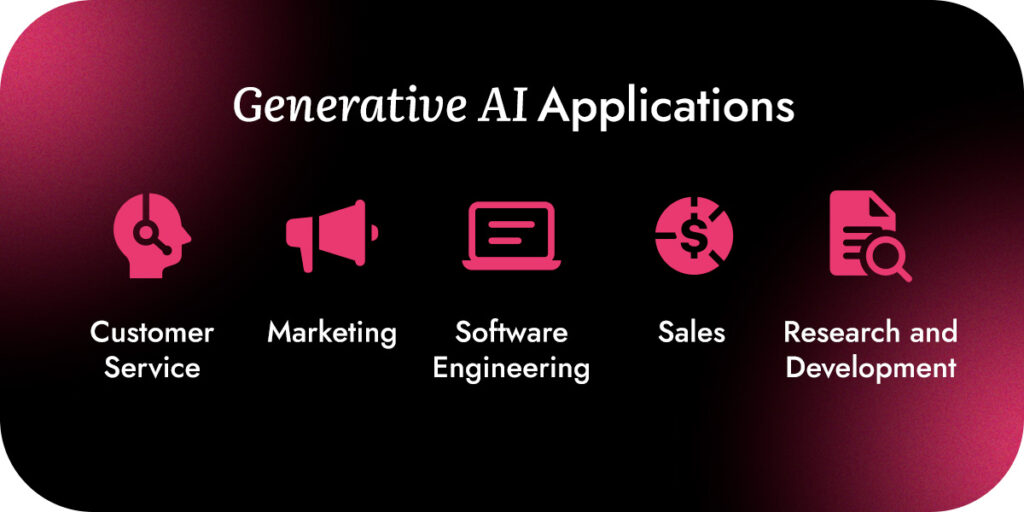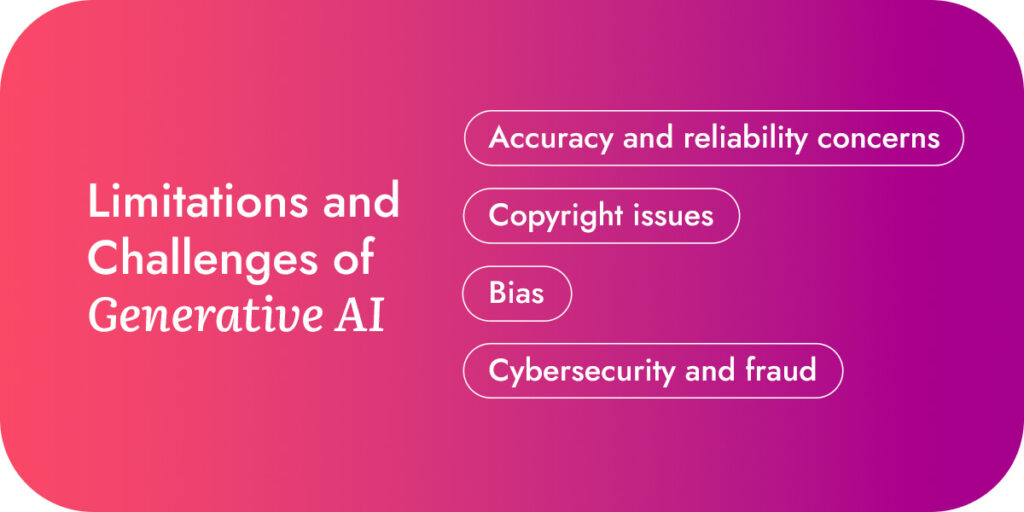
Generative artificial intelligence (AI) adoption has grown exponentially in recent years, with more than half of United States employees already using AI to complete work-related tasks. Generative AI presents many possibilities for creation, from producing music and art to entire virtual worlds. It also has practical uses, including optimizing various business processes.
In this guide, you’ll learn how generative AI works, its applications, and how to leverage it for business success.
What Is Generative AI?

Generative AI is defined as a type of artificial intelligence technology that can create various types of content, including text, video, images, music, and audio. Types of generative AI include:
- Text: Generative AI can produce essays, scripts, blogs, news articles, and even poetry. The training process involves consuming massive amounts of text from articles, books, and websites to find patterns and relationships in human languages. Examples of generative AI that can create text include Perplexity AI and ChatGPT.
- Imagery: This type of AI learns by analyzing image datasets with text descriptions or captions. This way, it can understand different concepts and merge them together to create an image. These image technologies can produce diverse images in various mediums, from oil painting style to animation.
- Sound: AI music generators are trained on various music tracks and metadata to find patterns and features across music genres. They can also learn lyrics to songs and create music.
- Coding: Generative AI technology can be exposed to large code datasets in various program languages, like Java. Through this training, they can detect patterns, structures, and practices in these languages to write and improve code.
- Video: Generative AI can create video from visual, text, and audio sources. They can even be trained on how to use video editing software and apply effects to existing videos.
- Research discovery: Many generative AI strategies can automate the research process and decipher complex texts. This type of AI can analyze research patterns and identify key information or produce summaries.
How Does Generative AI Differ From Other AI Technologies?
Here are the main differences between generative AI and other AI technologies:
- Generative AI vs. predictive AI: In contrast to generative AI, predictive AI uses patterns in past data to forecast outcomes and insights. Many organizations have used this technology to sharpen decision-making and develop data-driven strategies.
- Generative AI vs. conversational AI: Conversational AI helps AI systems like chatbots interact with humans in a natural way. It uses natural language processing and machine learning to understand language and provide human-like text or speech responses.
The Evolution of Generative AI in Recent Years
Over several decades, we’ve seen several advances in generative AI. The language modeling techniques that help form the foundation of generative AI can be traced back to the 1950s and 1960s. In the 2010s, generative adversarial networks (GANs) — a type of machine learning algorithm — were introduced, helping AI create convincingly real images, videos, and audio of real people.
Transformers, a type of machine learning, have also led to breakthrough language models. Transformers have made it possible for researchers to train larger models without needing to label the data beforehand. As a result, newer models are trained on larger datasets — generating answers with more depth.
Transformers also allow these models to discover connections between words across pages or books rather than in individual sentences. They can even be used to track connections to analyze chemicals, code, proteins, and DNA.
How Does Generative AI Work?
Generative AI is powered by machine learning models or neural network techniques to learn the patterns and relationships of human-created content. Training involves tuning the model’s parameters for different use cases and then fine-tuning those results. For instance, to create a chatbot for an e-commerce site, you might train it on common questions customers ask and the responses often given to them.
Additionally, there are different types of AI models that work in different ways, such as discriminative models. While generative AI models dive deep into the underlying distribution of input data to generate new samples that closely resemble training data, discriminative models focus on learning the decision boundary separating classes within the input data. Rather than modeling the dataset, they target the conditional likelihood distribution of labels from the input data.
Key Mechanisms Behind Generative AI
Generative AI technology specifically relies on algorithms like Variational Autoencoders (VAE) and GANs that are trained to capture underlying structures and probabilistic distributes that define the data. It then uses these learned patterns to generate new content.
- VAEs: VAEs consist of two neural networks, referred to as the encoder and decoder. The encoder is responsible for converting the input into a smaller representation of the data. With this compressed version, the decoder can then reconstruct the original input data and discard irrelevant information to generate novel data.
- GANs: GANs pit two neural networks against one another — a generator that produces new examples and a discriminatory one that learns to distinguish the new content as real (from the domain) or fake (generated).
As the models get smarter, they will produce better content, and the discriminator will get better at spotting generated content. The procedure then repeats, pushing improvements until the generated content is indistinguishable from the existing content.
It’s also important to learn about the architecture of AI generative models. The most common is the transformer network, which consists of multiple layers — self-attention, feed-forward, and normalization layers. These layers work together to decipher and predict streams of data, which could include text, protein sequences, or even images.
Generative AI Applications

Generative AI has the potential to enhance the customer experience, speed up product development, and improve employee productivity, spanning use cases from retail to research and development.
Here are just a few ways industries are leveraging generative AI for success:
Customer Service
Generative AI has led to improvements in customer operations, improving the customer experience and employee productivity through digital self-service and augmenting agent skills. One study found that a company with over 5,000 customer service agents saw increased issue resolution by 14% per hour and reduced time spent handling issues by 9%. Examples of operational improvements generative AI can make include:
- Customer self-service
- Reduced response time
- Resolution during initial contact
- Increased sales
Generative AI-fueled chatbots can provide immediate and personalized responses to customer inquiries, regardless of the complexity of the problem, or the language and location of the customer. Generative AI can also enhance coaching and quality assurance by gathering user insights, thereby increasing productivity and sales.
Ultimately, automation through generative AI can improve the quality and effectiveness of interactions, freeing up time for customer care teams to respond to inquiries only solvable by human agents.
Marketing
Generative AI can also transform marketing processes with efficient and effective content creation, SEO optimization, and product discovery. Here are some use cases for this technology in the marketing industry:
- Rapid content creation: Generative AI can reduce the time required to come up with content, saving teams time and effort. It can also ensure a uniform brand voice, writing style, and format, helping teams personalize marketing messages for different customer segments and demographics.
- Search engine optimization (SEO): Generative AI can lead to higher conversion for a reduced cost through SEO optimization. The technology can synthesize key SEO words, support content creation, and distribute the targeted content to customers.
- Product discovery: Generative AI can be personalized with text, images, and speech and a deep understanding of customer profiles. It can leverage customer user insights to help customers discover relevant products, helping companies achieve higher website conversion rates.
Sales
Generative AI also has the possibility to change how B2B and B2C companies approach sales by:
- Increasing probability of sale: Generative AI technology can identify and prioritize sales leads by gathering customer data, creating profiles, and suggesting actions to improve client engagement.
- Improving lead development: This technology can also help sales teams nurture leads by integrating relevant product sales and customer profiles to create discussion scripts for customer conversation. It can also automate follow-ups with customers, nurturing leads until the client is ready to interact with a human sales agent.
Software Engineering
Software engineering plays a significant role in many companies, and with generative AI, software engineers can use augmented coding and train large language models to generate code. Generative AI can lead to cost savings for companies by accelerating coding processes like creating initial code drafts and generating new system designs.
One study found that software developers using generative AI completed tasks 55.8% faster than those not using it. Another study found that by reducing the time needed for these tasks, engineers reported a better work experience, citing improvements in flow, happiness, and fulfillment.
Research and Development
The life sciences and chemical industries are already using generative AI foundation models in research and development. These foundation models can generate candidate molecules and accelerate drug development. In addition to increasing productivity in producing candidate designs, generative AI can optimize manufacturing designs, leading to cost reductions in production and logistics.
Generative AI can also be used to optimize health care processes, such as appointment scheduling and analytics, to help improve efficiency over time. Digital AI solutions can ultimately lead to improved patient care and hospital efficiency.
Limitations and Challenges of Generative AI

Since generative AI is so new, there are some inherent risks involved in using it — some recognized and some yet to be discovered. Examples of generative AI risks include:
- Accuracy and reliability concerns: While the information generative AI produces sound convincing, sometimes the information can be wrong. These models are still in the early stages of development, so it’s important to assess responses for appropriateness, usefulness, and accuracy before using them to distribute information.
- Copyright issues: Generative AI models are trained on large amounts of publicly available data. They are not designed to be compliant with copyright laws, making it important to pay close attention to your company’s use of AI.
- Bias: It’s also important to enact policies or controls that can detect bias within the AI outputs. That way, you can deal with them in a way that is consistent with your company policy and legal requirements.
- Cybersecurity and fraud: It’s important to be prepared for misuse of generative AI for cyber and fraud attacks, such as those that use deep fakes.
There are several ways to mitigate risks when implementing generative AI in businesses. By committing to guidelines and having safeguards in place, you can ensure the technology solutions are accurate, safe, and trusted to help your team flourish.
The Future of Generative AI
In the coming years, generative AI technology will continue to evolve, revolutionizing how we work. Reports predict that we will see $42 billion in annual spending by 2030 on generalized AI use cases, such as writing, researching, and summarizing strategies. More than 50% of this spending will be on communications platforms and chatbots — driving significant improvements in the customer and employee experience.
These tech solutions will make advancements in translation, drug discovery, and the generation of new content, from video and text to music and fashion design. We’ll also see a significant impact when integrating these capabilities with existing tools, such as grammar checkers and design programs.
More and more businesses will customize generative AI using their own data to improve communication and branding. Programmers will also use generative AI to enforce company-specific best practices for formatting and writing more readable, consistent code.
In the future, generative AI models will likely be expanded to support 3D modeling, product design, drug development, and business processes — making it easier to generate new product ideas and explore business ideas. When used for training, generative AI can automatically identify best practices to help train employees more efficiently in one part of an organization.
Preparing for What’s Next
Generative AI solutions are setting the pace for innovation and strategic leadership in the business world, fostering a culture of informed decision-making, optimized marketing strategies, and enhanced efficiency. With numerous advancements on the horizon for generative AI, you can stay ahead of the competition by implementing generative AI for your business.
To recognize the full potential of generative AI, consider collaborating with digital technology consultants. At Kopius, we can translate business problems into AI solutions. Collaborating with us can provide a competitive advantage, as we ensure AI aligns with your business objectives. We’ll identify areas where AI and machine learning can offer benefits, such as enhancing product offerings, improving customer service, or optimizing operational efficiency.
We can also help you mitigate generative AI risks like privacy concerns and potential biases in AI algorithms. Being proactive about these risks can enhance your organization’s reputation and give you a competitive advantage.
Partner With Kopius for Generative AI Innovation
Generative AI is much more than a technological strategy — it’s a transformative force reshaping the business landscape. As AI continues to evolve, its impact on executive leadership and business strategy will only increase. By effectively implementing AI, you can position your organization for success in the competitive business environment of the future.
Kopius can help you use generative AI to reach your objectives and achieve significant growth. Our consultants have the knowledge and expertise to maximize the benefits of AI and machine learning, allowing you to drive real and impactful results. By considering your unique needs and goals, we’ll develop a plan that works best for your organization. We can also help mitigate security risks associated with data breaches, regulatory violations, and data quality.
At Kopius, we’ve designed a program to JumpStart your customer, technology, and data success. Tailored to your needs, our user-centric approach, tech smarts, and collaboration with your stakeholders equip teams with the skills and mindset needed to:
- Identify unmet customer, employee, or business needs
- Align on priorities
- Rapidly prototype solutions
- And, fast-forward success
Gather your best and brightest business-minded individuals and join our experts for a hands-on workshop that encourages innovation and drives new ideas.
Contact us today to get started.

Related Services:
- Generative AI Solutions
- Data & AI Ideation Workshops
- Artificial Intelligence & Machine Learning Development